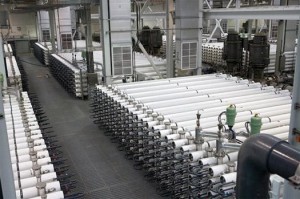
By Seren Nurgun, Staff Writer for Save The Water™ | October 21, 2015
Effective and safe water storage increases in value around the world, especially in drought-ridden California. Now more scientists are researching current storage methods. For example, a recent study details safe water storage from the Orange County Water District (OCWD) in Fountain Valley, CA. OCWD officials began to observe unusual spikes “in arsenic after it percolated into soils and sediments from surface basins into underground storage aquifers.”1 Unfortunately, the water that absorbed this excess arsenic had already “undergone a rigorous purification process.”1 Because of that, the officials expected the water to be clean and safe to consume.
Water Contaminated with Arsenic Has Been Tied to Skin Damage, Circulatory Problems, and Cancer Risks
Water contaminated with abnormal amounts of hazardous chemicals can cause physical harm to animals and humans. Specifically, arsenic-contaminated water has been tied to skin damage, circulatory system problems, and increased cancer risks.2 According to one published study, “arsenic exposure from drinking water has been associated with heart disease.”3 This 2013 study tested how “a history of arsenic exposure”3 affected the results of the record of heartbeats of the same group of women and men over a period of 5.9 years. In addition, a separate study mentions how drinking water with high levels of arsenic can cause lung cancer.4
OCWD Identifies Purification Process and Its Purified Recycled Water as Source of Arsenic Spikes
Because of these serious health risks, Orange County immediately reviewed its water system. The OCWD maintains a very high quality water purification process, known as the Groundwater Replenishment System (GWRS). Yet workers found spiked levels of arsenic near the groundwater monitoring wells. Of these, a few of these increases were slightly higher than the U.S. drinking water maximum of 10 micrograms per liter. Even though these spikes were not very dangerous, officials still wanted to investigate their cause. Because arsenic did not contaminate the water coming into the monitoring site, they reasoned that arsenic must have seeped underground to contaminate the water. The investigative OCWD team also concluded “only the purified recycled water triggered the arsenic spike.”1
Purification Makes Water Deficient in Calcium and Magnesium, Which Caused Arsenic Contamination
Following this discovery, a team from Stanford University’s School of Earth, Energy & Environmental Sciences found that there were in fact traceable amounts of arsenic directly above the aquifers. But scientists were still puzzled as to how this arsenic was making its way into the water. After conducting multiple experiments, the team concluding that post-purification water largely lacked calcium and magnesium. “[T]his deficiency caused calcium and magnesium atoms in the sediments to migrate into the water and off of charged clay particles that harbored the arsenic.”1 “With the calcium and magnesium ions leaving the clay surface, the arsenic ions were repelled from the clay surface and entered the water.”1
Adding Calcium Back Into the Water
The team at OCWD began to explore possible remediation methods on how to avoid arsenic spikes in the future. Ultimately, they decided “to add more calcium to the water during the treatment process.”1 After consulting their own specialists as well as the team from Stanford University, they figured that this was the best solution.
In conclusion, the OCWD and the scientists found a new way in which arsenic can contaminate an advanced water purification system. Now scientists and water management officials can begin to brainstorm more creative and effective ideas to solve future arsenic and other contamination.
References
- Ker Than. September 2, 2015. “Stanford Soil Sleuths Solve Mystery of Arsenic-contaminated Water.” Stanford News Service. https://news.stanford.edu/pr/2015/pr-arsenic-mystery-solved-090215.html
- United States Environmental Protection Agency. May 21, 2012. “Basic Information about Arsenic in Drinking Water.” http://bit.ly/2DBY0qm
- Yu Chen, et al. April 2013. “Arsenic Exposure from Drinking Water and QT-Interval Prolongation: Results from the Health Effects of Arsenic Longitudinal Study.” Environ Health Perspect Environmental Health Perspectives, 121(4). https://www.ncbi.nlm.nih.gov/pubmed/23384555
- David Dauphiné, et al. August 2013. “Case-Control Study of Arsenic in Drinking Water and Lung Cancer in California and Nevada.” International Journal of Environmental Research and Public Health, 10(8). https://www.ncbi.nlm.nih.gov/pmc/articles/PMC3774440/
- Stephen and Rob. “The Best Architecture of the Decade – Mammoth // Building Nothing out of Something.” The Best Architecture of the Decade. Mammoth. http://m.ammoth.us/blog/2010/01/the-best-architecture-of-the-decade/

